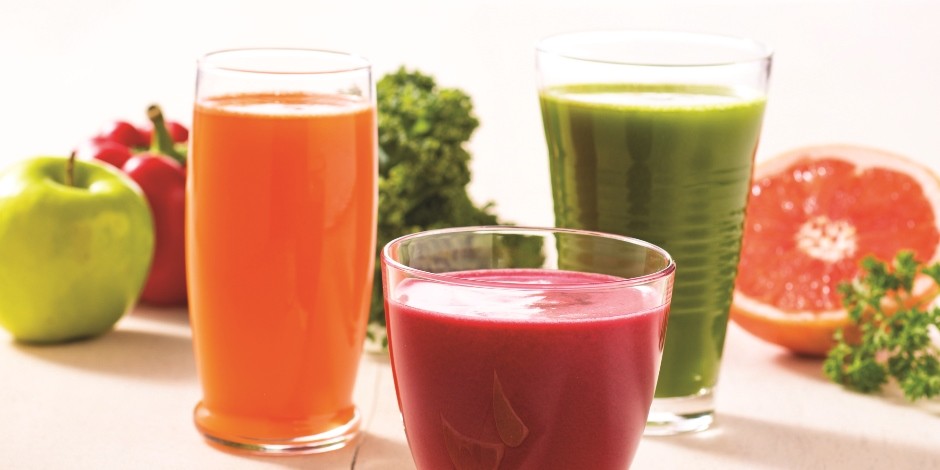Your mother was right: You have to eat your veggies if you want to be strong. But if you can’t (or won’t) eat them, sipping them can deliver the nutrients you need.
Nearly 90 percent of Americans fail to get their daily recommended servings of fruits (2 cups) and vegetables (2.5 cups), according to a 2010 study by the Centers for Disease Control and Prevention. If you dislike produce because of its taste or you suffer from the intestinal distress the high fiber content can cause, juicing is a palatable way to benefit from the hefty nutrient doses found in fruits and vegetables.
More calorie-dense than whole foods and higher in sugar content, fresh juice—like almost anything—is best enjoyed in moderation (aim for 8 to 10 ounces). But juicing has never been trendier or easier to do yourself. Here’s the lowdown on what you can juice and how.
Orange You Glad Juice
2 grapefruits, peeled
or 2 medium apples
5 carrots
1 inch peeled ginger
Red All Over Juice
1 red beet
1 carrot
1 celery stalk
2 plum tomatoes
2 cups of parsley
3 red radishes
Breakfast Envy Juice
1 medium green apple
1 medium cucumber
1 medium red bell pepper
1 cup kale leaves
1 medium tomato
1/2 medium lime
Pass all fruits and vegetables through a centrifugal or masticating juice extractor or use a high-performance blender or food processor for thicker juice. Drink immediately.
Leafy greens
Kale, collard greens, Swiss chard, spinach, cabbage, celery and parsley are loaded with vitamins and minerals and, when combined with cucumbers, tomatoes, carrots, apples and pears, they hardly taste like their whole versions. When juicing leafy greens, you’ll likely yield about 3 to 5 ounces of juice for every pound of produce, depending on your juicer. Strong centrifugal juicers can handle most greens, but masticating extractors are the best if you plan to juice often.
Veggies
Carrots, cucumbers and tomatoes top the list of juiceable veggies, but celery, broccoli, parsnips, beets, bell peppers and fennel are also great options. Pure vegetable juice can be strong and pungent and not for the faint of palate, but adding a low-sugar fruit, like a pear or a Granny Smith apple, or sweet herbs and roots, such as mint or ginger, balances veggies’ bitterness. Before juicing any vegetables, scrub them thoroughly or blanch them briefly in hot water to remove dirt and bugs without compromising their nutrients.
Fruits & Berries
Any fruit juice you can buy bottled in the store is worth trying to make at home. Beyond apples, oranges and cranberries, experiment with pineapple, cantaloupe, kiwi, grapefruit, pomegranate, peach, cherry, papaya, raspberries, blackberries and blueberries. Keep in mind, however, that juicing strips produce of all of its fiber content (unless you add the extracted pulp back into the juice; blending retains fiber), without which your body will absorb the fruits’ sugar content much more rapidly. Although the lack of fiber makes juice easy to digest and a good choice if you want to give your digestive system a rest, it also means you can end up with a sugar spike. Cut the sugar content of fresh juice by adding sweet potato or leafy greens to your drink. Or dilute the juice 50/50 with pure water.
4 Tips to Maximize the Benefits
1. Timing is Everything
Fresh juice oxidizes quickly, so make only what you’ll drink immediately. For optimal nutrient absorption, drink your fresh juice early in the morning on an empty stomach.
2. The Right Balance
To keep sugar content in check, aim for at least a 3-to-1 veggie-to-fruit ratio with your mixtures. As you get more comfortable with the taste, you can up the veggie content.
3. Punch Up With Protein
Blend your juice with a spoonful of chia seeds, protein powder, or a bit of nut milk or Greek yogurt to make a protein-packed smoothie.
4. Warm Up
Fruits and veggies juice best when they’re at room temperature, so take them out of the refrigerator a few hours or the night before juicing.

